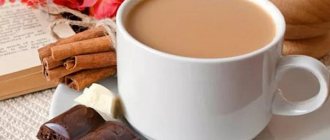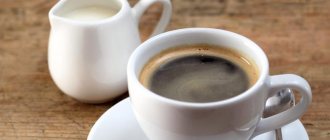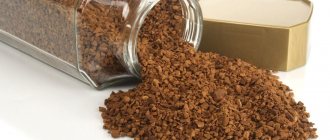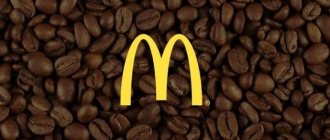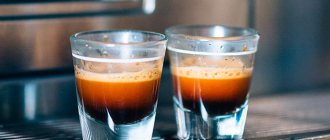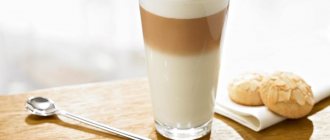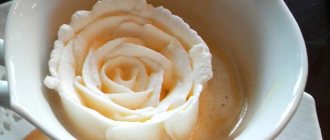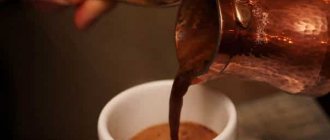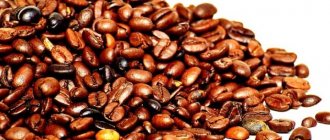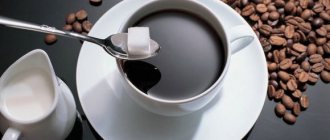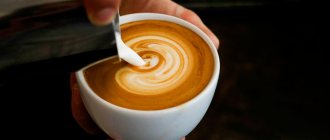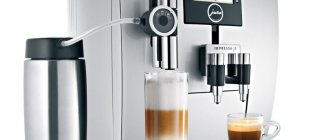Cappuccino, a medium-calorie drink popular in Europe, owes its origin to black coffee-loving Capuchin monks. Connoisseurs of the aroma and taste of boiled coffee beans, fearing to be accused of having connections with the devil, came up with the idea of mixing the forbidden drink with milk, which was considered “pure” by the inquisitors.
Members of the order liked the original taste so much that they decided to froth the milk. But the resulting consistency quickly collapsed, so it was decided to use slightly warmed milk or cream. Later, a cappuccino machine was invented for the drink beloved by Europeans, which allowed milk to be whipped into a strong foam without sugar using steam.
Nutritional value and chemical composition
The calorie content of the drink without added sugar is about 62 kcal, which directly depends on the fat content of milk and cream added to the mixture. According to the traditional Italian recipe, cappuccino is prepared from espresso and heated milk, half of which turns into creamy milk foam under the influence of steam.
For taste, a variety of syrups, sugar, spices and chocolate chips can be added to the drink.
Cappuccino. Calorie content of the drink and BJU.
Chemical composition:
| Substance | Content |
| Squirrels | 0.84 g |
| Fats | 2.1 g |
| Carbohydrates | 11.7 g |
| Alimentary fiber | 0 |
| Water | 0 |
The espresso itself contains only 1-2 kcal. The remaining food units are gained by adding a creamy milk component.
Vitamins and beneficial properties
Cappuccino (calories without sugar are given in the article) is a mixture of black espresso and a creamy milk mixture that gives Arabica beans a pleasant creamy taste and aroma.
Thanks to the milk component, cappuccino contains many useful elements:
| Substance | Content |
| Vitamins |
|
| Micro- and macroelements |
|
| Omega-6 | 37.4 mg |
Adding a large amount of milk reduces the negative qualities of caffeine, additionally providing the body with the beneficial elements necessary for proper functioning.
The beneficial qualities of the drink include:
- a good invigorating effect that allows you to gently combat drowsiness;
- contains a large amount of the “joy hormone”, which actively copes with stressful situations and the consequences of depression;
- assistance in restoring the body after suffering heavy mental and physical stress;
- reducing the frequency and intensity of migraines, which is especially important for people suffering from VSD;
- increased concentration;
- regulation of blood glucose and prevention of acquired diabetes mellitus;
- aid in weight loss (as a hunger blocker);
- due to the large amount of antioxidants, the drink reduces the likelihood of developing cancer, liver cirrhosis and Parkinson's disease;
- regulation of the gastrointestinal tract;
- normalization of blood circulation, improvement of blood composition and reduction of the risk of cardiovascular pathologies;
- replenishment of the body with the amount of calcium and fluoride necessary for the good condition of bone tissue and teeth, washed out when drinking natural espresso.
Adding milk and cream reduces the negative effect of caffeine on the gastrointestinal tract, helping to reduce increased secretion and prevent increased production of hydrochloric acid.
Cappuccino consumption is recommended for women during pregnancy. Coffee lovers should definitely add milk mixture to their rich espresso. A tasty drink will help wake up the body faster, while replenishing calcium and fluoride reserves.
Types of cappuccino
Cappuccino (the calorie content of a sugar-free drink depends on the fat content of the added milk component) initially contained 1 part espresso (30 ml), 2 parts milk, with the inclusion of milk foam (60 ml). Coffee lovers improved the recipe by preparing cappuccino from 60 ml of espresso and the same amount of milk. The surface of the drink is decorated with a pattern and sprinkled with cinnamon, ginger, and ground chocolate.
Depending on the method of preparation and additives they differ:
- Black cappuccino . Consists of black coffee with the addition of milk foam or cream.
- White . More similar to a latte and consists of adding espresso to the creamy part.
- Cold brew , made by whisking and combining cold espresso, milk and foam.
- Iced cappuccino . Prepared from chilled ingredients with the addition of ice cubes.
- Dry . The strongest option, requiring mixing cream and espresso in equal proportions.
- Chiaro . A milk cappuccino containing a minimal amount of coffee and a large amount of milk, heated to a very high temperature and less frothed.
- Starbucks . Diet cappuccino made from skim milk. This serving contains only 20 kcal. The foam for the drink is very loose.
- Latte cappuccino . A layered version of a coffee-milk mixture, in which espresso is placed at the very bottom, milk foam is placed second, and whipped cream completes the composition.
- Chocolate, nutty, caramel. It is obtained by adding syrup with a certain taste and chocolate or nut crumbs.
- Milk whipped with decaffeinated syrup.
How many calories are in a standard serving of cappuccino without sugar?
For preparation you need:
- milk - 100 ml
- coffee - 100 ml
Coffee is brewed using the standard method. The milk is heated over a fire and then whipped into a thick foam using a cappuccino maker. The foam is carefully transferred into a cup of drink.
Calorie table per 100 grams of drink:
| Product | Measure | Kcal |
| Milk | 100 ml | 64 |
| Ground coffee | 100 ml | 2 |
| Total | 200 gr | 68 |
| 100g | 100 gr | 34 |
After calculations, it turned out that a traditional drink without sugar and additives has 34 Kcal per 100 ml of product.
Calorie content of various types of cappuccino
Cappuccino (the calorie content of a sugar-free product, subject to a recipe requiring the use of full-fat milk (3.5-4% fat) is about 62-74 kcal) according to the classic recipe contains 30 ml of espresso, milk and milk foam.
In modern coffee shops, taller glasses of 150-180 ml are used to serve cappuccino, which allows you to increase the amount of coffee (up to 60 ml) and milk components (up to 100-120 ml).
Most often, milk with a fat content of 3.5-4% is used to prepare the drink, which allows you to quickly obtain stable foam. The calorie content of such a product in 100 ml is about 60 kcal. From 100 to 120 ml can be added to a glass, which equals 70 kcal.
Using this data you can calculate that:
- in a 150 ml glass – 62 kcal;
- in a 180 ml glass – 74 kcal.
In coffee shops, regular milk or low-fat (10%) cream is used to make the drink, which makes it possible to obtain stable foam. But many establishments offer a service for selecting the components of the drink, which makes it possible to independently calculate the energy value of cappuccino.
| Fat content of milk or cream | Calorie content per 100 ml |
| 0,1% | 32 kcal |
| 1,5% | 45 kcal |
| 2,5% | 53 kcal |
| 3,5% | 62 kcal |
| Soy milk (0.1%) fat content | 29 kcal |
| Soy milk (0.6%) fat content | 44 kcal |
| Cream, low fat | 61 kcal |
| Cream 10% fat | 122 kcal |
Popular cafes always indicate the calorie content and composition of the product served on the menu, giving the client the opportunity to adjust the drink to his taste.
Energy value of cappuccino in well-known retail chains:
| Commercial network | Calories |
| McDonald's (200 ml) | 76 kcal |
| Starbucks (350 ml) | 143 kcal |
| Coffeemania (330 ml) | 95 kcal |
| CoffeeHouse (100 ml) | 65 kcal |
| Chocolate girl (320 ml) | 145 kcal |
In coffee machines, drinks are poured into standard 200 ml cups. Most often they use 2.5% fat milk and natural coffee beans. A standard serving of cappuccino contains about 65 kcal at the rate of 2+ 63 = 65.
Instant Cappuccino, sold in popular retail stores, has nothing in common with a real coffee drink, since it is a simple soluble milk concentrated powder with various sweeteners and additives. The energy value and complete components of the drink are indicated on the bag.
| Name | Calories |
| TORABIKA Cappuccino (25 g) | 110 kcal |
| LaFesta Cappuccino (25 g) | 116 kcal |
| MacCoffee Cappuccino (25 g) | 106 kcal |
To prepare the drink, one package of concentrate is used. If 2 servings are used, the given energy value is multiplied by 2.
Adding chocolate, sugar or syrups to cappuccino significantly increases the calorie content of the product:
- a spoonful of any syrup for 35-40 kcal;
- 1 tsp. refined sugar for 19.6 kcal;
- a piece of cane sugar for 20 kcal.
Italian coffee from McDonald's - how many calories?
Connoisseurs of the menu of an American fast food restaurant will find it useful to know the calorie content of cappuccino at McDonald's, which is affected by the volume of the drink. Customers are offered coffee in 0.3 and 0.2 liter glasses. In the first case, cappuccino without sugar has 125 kcal, in the second - 75 kcal.
When calculating the energy value of Italian coffee with milk and airy foam, you should think about replacing sugar with natural honey, candied fruits, and dark chocolate in small quantities. In this combination, the drink will not harm your figure and will bring no less pleasure.
You might be wondering: Is there caffeine in instant coffee?
How to use in dietetics and weight loss
People on a diet can consume the drink no more than 1-2 times a day, using only natural coffee beans and skim milk for its preparation.
Replacing espresso with cappuccino during a diet will help:
- prevent the active production of hydrochloric acid, which has a destructive effect on the walls of the stomach;
- replenish the body's reserves of calcium and phosphorus, washed out under the influence of caffeine;
- normalize digestion and preserve gastric microflora;
- prevent destruction of nails and split hair.
For the diet, cappuccino is prepared independently or using a coffee machine only from skim or non-fat (2.5%) milk without improving the taste with syrup, sugar and chocolate. Ground spices (cinnamon, ginger, nutmeg) can be added to the drink and poured onto the creamy foam.
In addition to cappuccino, the daily diet consists of:
- low-fat fermented milk products;
- hard, low-calorie cheeses;
- lean types of meat, fish and poultry;
- a variety of vegetables and fruits (except corn, potatoes, bananas and grapes);
- cereals steamed with boiling water or boiled in water;
- at least 1.5-2 liters of water per day.
On a diet, you can drink cappuccino no more than 2 times a day in the morning (for breakfast) or by replacing one of the snacks with the drink.
Sample menu for 7 days:
| 1-4th day | Menu |
| Breakfast | Low-fat cottage cheese with dried fruits; cappuccino |
| Snack | Cappuccino |
| Dinner | Onion soup with boiled chicken |
| Snack | Orange |
| Dinner | Salad of cucumbers, tomatoes and radishes with baked cod fillet |
| 2-5th day | |
| Breakfast | Boiled eggs; cappuccino |
| Snack | Cappuccino |
| Dinner | Stewed zucchini with carrots and peppers |
| Snack | Apples |
| Dinner | Vegetable and seafood salad |
| 3-6th day | |
| Breakfast | Cappuccino; grain bread toast with cream cheese |
| Snack | Cappuccino |
| Dinner | Cheese salad with baked tomatoes, boiled chicken and herbs |
| Snack | Plums |
| Dinner | Fruit salad with bio-yogurt fruit salad with bio-yogurt |
| 7th day | |
| Breakfast | Buckwheat steamed with boiling water; cappuccino |
| Snack | Cappuccino |
| Dinner | Carrot meatballs with rice |
| Snack | A pineapple |
| Dinner | Grilled vegetables |
You need to stick to this diet for 7 days. If the body tolerates it well, it is allowed to extend the diet for up to 10 days.
How to make cappuccino
Cappuccino (you can calculate the calorie content of a sugar-free drink served in various restaurants yourself or ask the barristo to use low-calorie products) according to another version, was created not by Italian monks, but by the author of the coffee machine, Luigi Bezzera. Having brewed espresso in 1901, the Italian tried to use the steam produced by a milk frothing machine.
The drink received its original name from the clothing of members of the Capuchin Order, which it very closely resembled in color.
According to Italian tradition, cappuccino needs to be prepared from 60 ml of espresso and the same amount of milk, half of which turns into a foamy state when whipped.
For ease of preparation, Italian technicians have developed a special cappuccino maker, which is a durable metal tube that supplies steam under pressure, easily frothing the milk. The cappuccino foam is made very dense and must withstand the pressure of 1 tsp. refined sugar
Classic recipe
A cappuccino is prepared from 60 ml espresso, 30 ml milk and 30 ml milk foam. For the drink, you can use ground, whole grains or instant granules.
Recipe:
- From 1 tsp. Instant granules or whole beans are used to prepare espresso. When using roasted Arabica coffee, it is first ground and then boiled in a Turk for 2-3 minutes. until boiling and leave.
- Milk (60 ml) with a fat content of 3.5% is heated to 65-75 degrees, and then whipped with a mixer, blender or cappuccino maker until foamy (the mixture doubles in size).
- Espresso is poured into a warm glass and mixed with milk.
- Foam is placed on top of the drink with a spoon, decorated with chocolate chips or spices.
- Syrups and sugar are added to the drink to taste.
For a dietary diet, espresso is prepared from whole Arabica beans independently or using a coffee machine, and then mixed with foam from skim or 2.5% fat milk. Do not use coffee granules or ground beans.
With chocolate
Recipe:
- In a Turk, espresso is prepared from coffee beans.
- Melt 2-3 pieces of milk or dark chocolate.
- Milk (3.5% fat) is heated in a microwave oven or over an open fire to 65-75 degrees, and then whipped into a strong foam with a mixer.
- Espresso and melted chocolate are poured into a tall, slightly warmed glass and mixed. Gently holding the foam, pour milk into the mixture using a spoon and mix everything together.
- Foam is smoothed over the drink, decorated with chocolate chips.
With syrup
For coffee drinks, it is best to use chocolate, caramel, nut or vanilla cream syrup. Fruit drinks do not combine well in taste and can cause milk to ferment.
Recipe:
- Brew a drink from coffee beans (1 tsp) until it boils, and then infuse for 3 minutes.
- 60 ml of milk is heated and whipped until a foam appears that can withstand a spoonful of granulated sugar.
- First pour espresso into a tall glass, then pour milk and 1 tbsp. l. any syrup. The mixture is stirred.
- The drink is topped with milk foam, decorated with a pattern, chocolate chips and cinnamon.
With cream
Cream for cappuccino should be no more than 10% fat.
Recipe:
- Espresso is prepared from coffee beans over a fire or in a coffee machine.
- 60 ml of cream is heated in any way to 65-75 degrees, and then foamed with a mixer or blender.
- Espresso and cream are poured into a tall, slightly warmed glass and then mixed. Syrup can be added to the drink if desired.
- Creamy foam is placed on top of the drink with a spoon.
- Decorated with cappuccino chocolate.
Iced cappuccino
The chilled drink is made from cold milk, espresso and ice cubes.
Recipe:
- From 1 tsp. coffee beans, espresso is brewed and cooled.
- 30 ml of cold espresso, 60 ml of cream (or milk), ground ice are blended in a blender until bubbles appear.
- The mixture is poured into a tall glass and decorated with chocolate chips and spices.
Cappuccino is served in a preheated tall (120-150) ml glass and garnished with ground chocolate or cinnamon. There is a special Latte Art trend in which a drawing is placed on the surface of the milk foam. Some barristos are so successful in this art that they can depict not only an ornament, but also any animal or portrait of a person.
In Italy, a coffee-milk drink containing 62-72 kcal should be drunk only before 11 am. It is advisable to drink cappuccino without sugar at breakfast, complemented with fresh pastries.
After lunch, Italians do not drink milk-based coffee drinks, preferring to finish any meal with low-calorie espresso. Americans, on the contrary, can drink coffee at any time of the day, combining the drink with a fairly hearty lunch or dinner.
Cappuccino at home
You can make a classic Italian cappuccino yourself, getting a lot of pleasure from the process itself, and then from the aromatic drink.
Components:
- 2 teaspoons of ground coffee beans;
- 2 teaspoons sugar;
- 100 g milk;
- 100 g water;
- grated chocolate at your discretion.
Cooking technology:
- Pour coffee and sugar into a cup and stir well.
- Pour boiling water over it, and while the coffee is steeping, make milk foam.
- Bring the milk to a boil on the stove and immediately pour it into a blender, where you beat until foam forms.
- Pour the foam over the coffee and sprinkle chocolate on top.
The beauty of making cappuccino at home is that you can regulate its calorie content yourself. For example, take milk with a lower percentage of fat content, or add less sugar, and if you are on a diet, avoid it altogether, use dark chocolate (it has less calories), or replace it with cinnamon.
Or you can slightly modify the recipe , adding various ingredients as desired, and invent your own signature cappuccino recipe.
